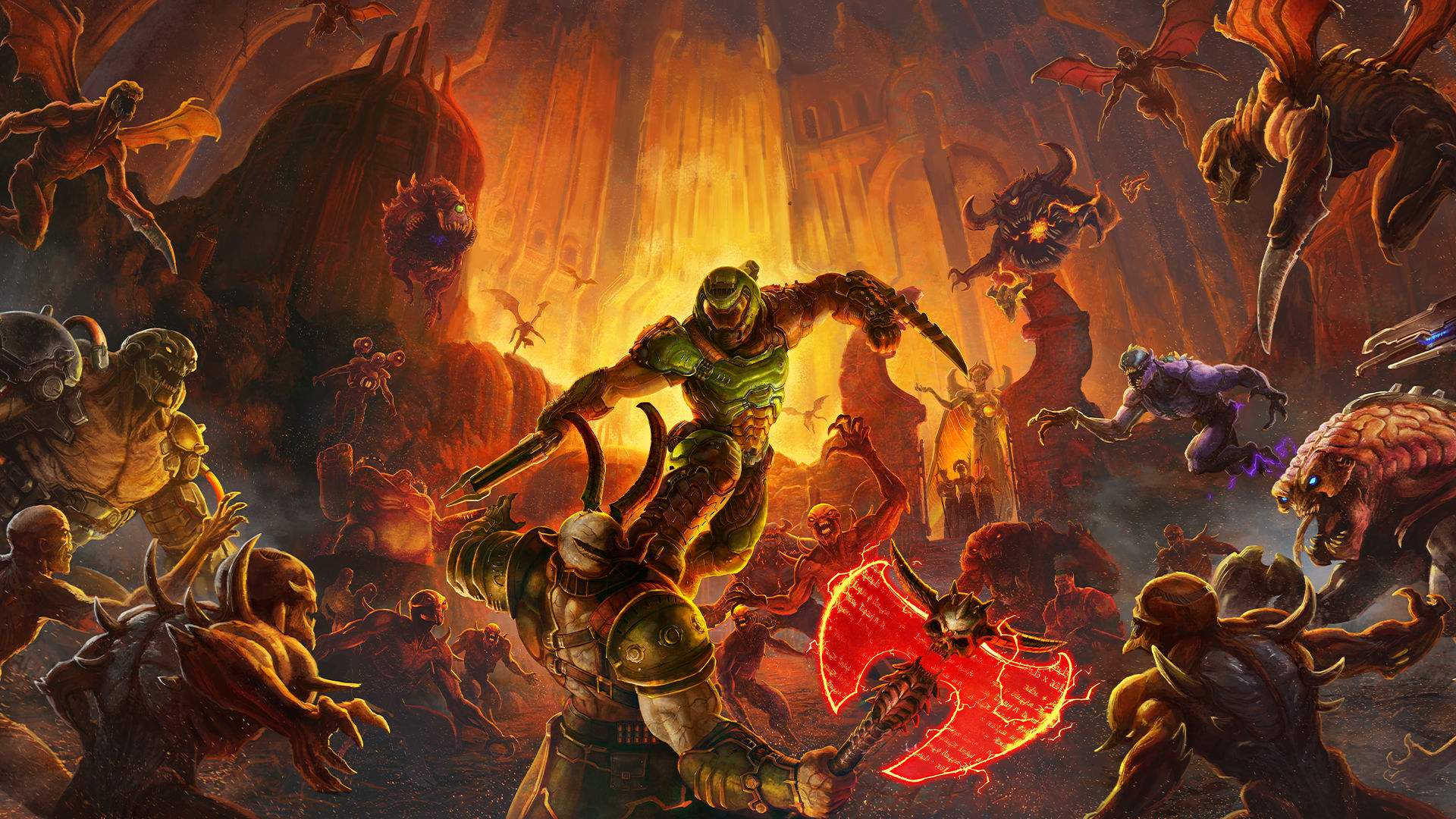Rip and Tear 2: Electric Boogaloo
Back in 2016, Bethesda was following a policy that limited early review access to its games.
Doom fell under said policy, which led to concerns regarding its quality, and whispers that Bethesda wasn’t confident in it. It only took five minutes of playing it, tops, for people to realize that wasn’t true, and that Doom categorically ruled.
Bethesda didn’t make the same mistake with Doom Eternal.

Doom Eternal (PC, PS4 [reviewed on a PS4 Pro], Stadia, Switch, Xbox One)
Developer: id Software
Publisher: Bethesda Softworks
Release: March 20, 2020 / Switch (TBA)
MSRP: $59.99
I don’t necessarily need a story in a Doom game, but Eternal‘s got one.
The approach is a bit different and wholly old-school: less “uncovering a mystery” and more “rip and tear,” with the hellish motif front and center as Earth has already been subjugated by demons. There’s plenty of lore to read and some cutscenes available if you want them, but Eternal is very much content keeping action at the forefront. The gist is that you need to hunt down priests that have besieged Earth to save it, and hunt you will.
Eternal‘s best beats involve the enhanced focus on the hero, the “Doom Slayer,” as well as the Slayer mythos as a whole and what makes him tick. His characterization of a badass that gets things done without being a stone-cold killer of men rules, as he never skirts the line of unlikability and radiates personality even if most of his dialogue consists of grunts. Beyond a very abrupt ending, the reductive narrative serves Eternal well.
Gameplay is also equally urgent. One of my favorite things about the new Doom reincarnation (Eternal included) is how id Software once again nails the sense of speed. You get a double-jump immediately, you get double-dashing soon after, and it gets better from there. Eternal brings back the idea of wielding a (limited-use) chainsaw to recover ammo and ripping apart weakened enemies with “glory kills” for health, but adds in two other wrinkles: the “Flame [Thrower] Belch,” which burns enemies in exchange for armor shards, and a super punch of sorts that refreshes after glory kills.
This leads to a rapid-pace self-sustaining economy of power-ups, where you periodically chainsaw, burn, or glory kill to keep your run going. If you saw, torch, and rip apart things correctly, you’ll always have a stream of health, armor, and ammo respectively without having to rely on pickups. It sounds confusing but it’s more natural and intense in practice, especially when you’re juggling a room full of varied enemies on a tougher difficulty setting. It’s still so refreshing to not have to manually reload.
Those enemies, mind, also have more of a strategic overarching design. They have more pronounced weakpoints that encourage you to surgically take out enemies in specific ways, like shooting the tail off of a Spiderdemon to thwart its long-range capabilities, or throwing a grenade into a Cacodemon’s mouth to instantly trigger a glory kill prompt. It feels really gamey at first, but once you’re overwhelmed in a giant arena full of varied foes, trying to figure out the best way to approach each and every fight, it feels more justified. The only hiccup is when you annoyingly have to hunt down that one last demon until a critical path door opens.

During my tests, performance was great on a PS4 Pro, consistently rolling along at 60FPS, with 10-second-or-less load times. I encountered a few moments of stuttering during cutscenes (but rarely during gameplay), and one stuck checkpoint that I needed to reload to trigger. That’s it. Everything is communicated on the HUD and accessibility options are available, including HUD alterations, even on consoles. When you add in more customization for the Slayer (like out-there rune passive abilities, returning weapon mods, and stat-increasing level-ups), it gets even more engaging.
Once again maps feel acutely designed to provide a great deal of exploration while remaining pointed. Environments have a looser aesthetic, ripped free of the shackles of the mostly Mars/Hellscape motifs of Doom 2016: we’re galaxy-hopping now. Individual maps beg to be explored with the “fast travel” mechanic (which sounds stupid in a Doom game at first) that lets players jump to different points of a map right before its finale. In other words, it’s a way to grab stuff you missed before you leave and have to restart the entire level over.
Despite the hardcore-looking veneer, things are loosened up a bit in general. You can swap difficulty settings at any time without penalty (with the exception of the permadeath settings, which are essentially different modes). Cheat codes are also available and do not disable progression. The game gets weird with select moments where you possess a drone of a demon and wreak havoc, and the campaign is still mission-based, as it traditionally has been since the start.

A Fortress of Doom hub (which I call the “Doom Room”) allows for a bit of respite and a way to store your collectibles between missions, like a fun interactive “next mission” menu. It’s kind of like Mortal Kombat‘s Krypt but without the microtransaction baggage. You can of course go back into any completed mission for a 100% clear, and periodic “Master Levels” are available, which are remixed, tougher stages that give hardcore players a reason to run through them a third time. For disclosure, we did not have access to the multiplayer-centric “Battlemode” for this review outside of the brief tutorials, and as such it covers the single-player campaign.
Doom Eternal keeps the strong foundation built back in 2016 intact, while adding some of its own panache in the process. I think we can officially declare that the last iteration wasn’t just a lone fluke, and that Doom is back in the shooter spotlight where it belongs.
[This review is based on a retail build of the game provided by the publisher, covering the single-player portion of the game.]


